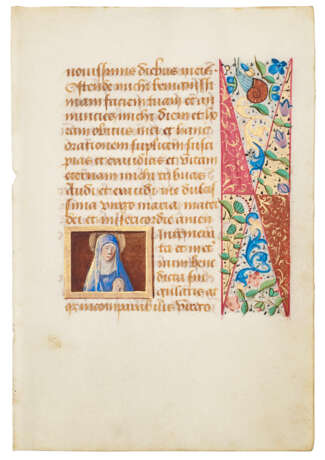ID 1032868
Los 216 | A group of leaves from Medieval and Renaissance manuscripts
Schätzwert
$ 3 000 – 5 000
7 leaves, including:
(i) A leaf from a noted Breviary, in Latin, decorated manuscript on vellum [northern Germany, possibly Rhineland?, 13th century]. c.250 x 195mm., 11 lines written in an early Gothic script, hufnagelschrift notation on a single red line clef, the text for the 20th and 21st Sundays after Pentecost, one large decorated initial 'O' in red with intricate penwork decoration and green wash opening the Feast for the 20th Sunday after Pentecost 'Omnia que fecisti', 5 calligraphic initials in brown ink with red penwork flourishing, one tall initial 'I' in red and blue, other initials in red or blue, rubrics in red, contemporary foliation 'cxxxiii' (recovered from use as binding material and with consequent creases and stains, verso with remnants of old binding, edges folded over, a few holes). Mounted and framed. Provenance: Bloomsbury Auctions, 9 December 2015, lot 18.
(ii) A leaf from a Book of Hours, in Latin, illuminated manuscript on vellum [southwest France?, early 15th century]. c.150 x 100mm. 17 lines of text with the end of the Office of the Dead and the beginning of the Hours of the Cross in a Book of Hours, pale ink foliation in pen '152', illuminated puzzle initials and dense fleur-de-lys full border with scrolling penwork in red and blue, smaller initials in blue with red penwork flourishing, rubrics in red. Mounted and framed. Provenance: The parent manuscript, then apparently complete, was offered by Sam Fogg, cat. 14 (1991), no 20. It included notes concerning the Cochon family dating from the 16th to 17th centuries, with several mentions of Rennes. Subsequently in the collection of Leo S. Olschki, Manuserits sur velin avec miniatures du Xe au XVIe siecle (Catalogue LX XIV), Florence, 1910, no 38, pp.53-54, pls XXI-XXII; and finally Count Paul Durrieu, Paris (1855-1925) and to his heirs. The manuscript was presumably broken up some time after 1991. Peter Kidd discusses it in his blog, Medieval Manuscripts Provenance, in an entry dated 11 May 2019. The style of illumination is extremely unusual, and has previously been attributed to Spain, Italy, and Aix/Marseilles.
(iii) A leaf from a grisaille Book of Hours, in Latin, illuminated manuscript on vellum [southern Netherlands, Bruges?, c.1470s]. c.95 x 75mm. 17 lines of text opening matins in the Hours of the Virgin from a Book of Hours, large illuminated initial 'D', smaller illuminated initials on red or blue backgrounds, all within a full grisaille foliate border, the text framed on three sides, rubrics in red (text of the rubric a little faded). Mounted and framed.
(iv) The Virgin in prayer, small miniature on a leaf from a Book of Hours, in Latin, illuminated manuscript on vellum [France, Tours, c.1480-90]. 140 x 96mm. 17 lines of text, including the end of the Obsecro te and the beginning of O intemerata from a Book of Hours, the small miniature illuminated by a follower of Jean Bourdichon, panel border on recto and verso. Mounted and framed.
(v) A leaf from a Book of Hours, in Latin, illuminated manuscript on vellum [Paris or Tours, c.1520s]. 112 x 63mm. 21 lines of text, ruled space: 77 x 34mm, the text from the Seven Penitential Psalms in a Book of Hours, foliated '201', initials in black and liquid gold, all within a liquid gold border with looping tassels at the bottom. Mounted and framed. Provenance: From a Book of Hours belonging to Baron Jerome Pichon (1812-1896): his sale in Paris, 18 April 1869, lot 18. The manuscript subsequently appeared with Sam Fogg, cat.14 (1991), no 39; afterwards broken up. The manuscript was illuminated by the Bellemare group, named for their association with Noël Bellemare, the Antwerp-trained painter under whose direction an entirely new style was introduced to French manuscript illumination in the second quarter of the 16th century. Leaves from this dismembered manuscript were described in Pirages, cat. 49, nos. 88-95. Other leaves from the same manuscript are described in S. N. Fliegel, The Jeanne Miles Blackburn Collection of Manuscript Illuminations, Cleveland Museum of Art, 1999, pp.71-2, no 69.
(vi) Two leaves from an Italian Book of Hours, in Latin, illuminated manuscript on vellum [Italy, 15th century; the illumination 19th century]. Each leaf c.127 x 95mm. 11 lines, ruled space: 66 x 43mm., the text of both leaves from the Seven Penitential Psalms in a Book of Hours, the historiated initial with the Virgin and Child opening (mid-sentence): '[Respondit ei in via virtutis suae] paucitate[m] dierum meorum nuntia mihi', initials alternately in blue or red, text leaf with a large penwork initial in blue, the illumination (historiated initial, full border with birds and coat of arms, illuminated initial extending into the margin) added in the 19th century (some fading of text). Mounted and framed.
| Genre: | Religiöses Genre |
|---|---|
| Herkunftsort: | Frankreich, Deutschland, Die Niederlande |
| Kategorie des Auktionshauses: | Handschriften des Mittelalters und der Renaissance |
| Genre: | Religiöses Genre |
|---|---|
| Herkunftsort: | Frankreich, Deutschland, Die Niederlande |
| Kategorie des Auktionshauses: | Handschriften des Mittelalters und der Renaissance |
| Adresse der Versteigerung |
CHRISTIE'S 20 Rockefeller Plaza 10020 New York Vereinigten Staaten | ||||||||||||||
|---|---|---|---|---|---|---|---|---|---|---|---|---|---|---|---|
| Vorschau |
| ||||||||||||||
| Telefon | +1 212 636 2000 | ||||||||||||||
| Fax | +1 212 636 4930 | ||||||||||||||
| Nutzungsbedingungen | Nutzungsbedingungen | ||||||||||||||
| Versand |
Postdienst Kurierdienst Selbstabholung | ||||||||||||||
| Zahlungsarten |
Banküberweisung | ||||||||||||||
| Geschäftszeiten | Geschäftszeiten
|



